Wai-Fah Chen.The Civil Engineering Handbook
Подождите немного. Документ загружается.


© 2003 by CRC Press LLC
Inverse Trigonometric Functions
The inverse trigonometric functions are multiple valued, and this should be taken into account in the
use of the following formulas.
sin
3
A
1
4
--
3 A 3Asin–sin( )=
cos
3
A
1
4
--
3A 3 Acos+cos( )=
ixsin
1
2
--
ie
x
e
x–
–()i xsinh= =
icos x
1
2
--
e
x
e
x–
+() xcosh= =
ixtan
ie
x
e
x–
–()
e
x
e
x–
+
----------------------- i xtanh= =
e
xiy+
e
x
yi ysin+cos( )=
xi xsin±cos( )
n
nx i nxsin±cos=
sin
1–
x
1–
1 x
2
–cos=
tan
1–
x
1 x
2
–
-----------------
ctn
1–
1 x
2
–
x
-----------------
= =
sec
1–
1
1 x
2
–
-----------------
csc
1–
1
x
--
= =
s– in
1–
x–()=
1–
xcos sin
1–
1 x
2
–=
tan
1–
1 x
2
–
x
-----------------
ctn
1–
x
1 x
2
–
-----------------
= =
sec
1–
1
x
--
csc
1–
1
1 x
2
–
-----------------
==
π
1–
x–()cos–=
tan
1–
x ctn
1–
1
x
--
=
sin
1–
x
1 x
2
+
------------------
1–
1
1 x
2
+
------------------
cos= =
sec
1–
1 x
2
+ csc
1–
1 x
2
+
x
------------------
= =
t– an
1–
x–()=
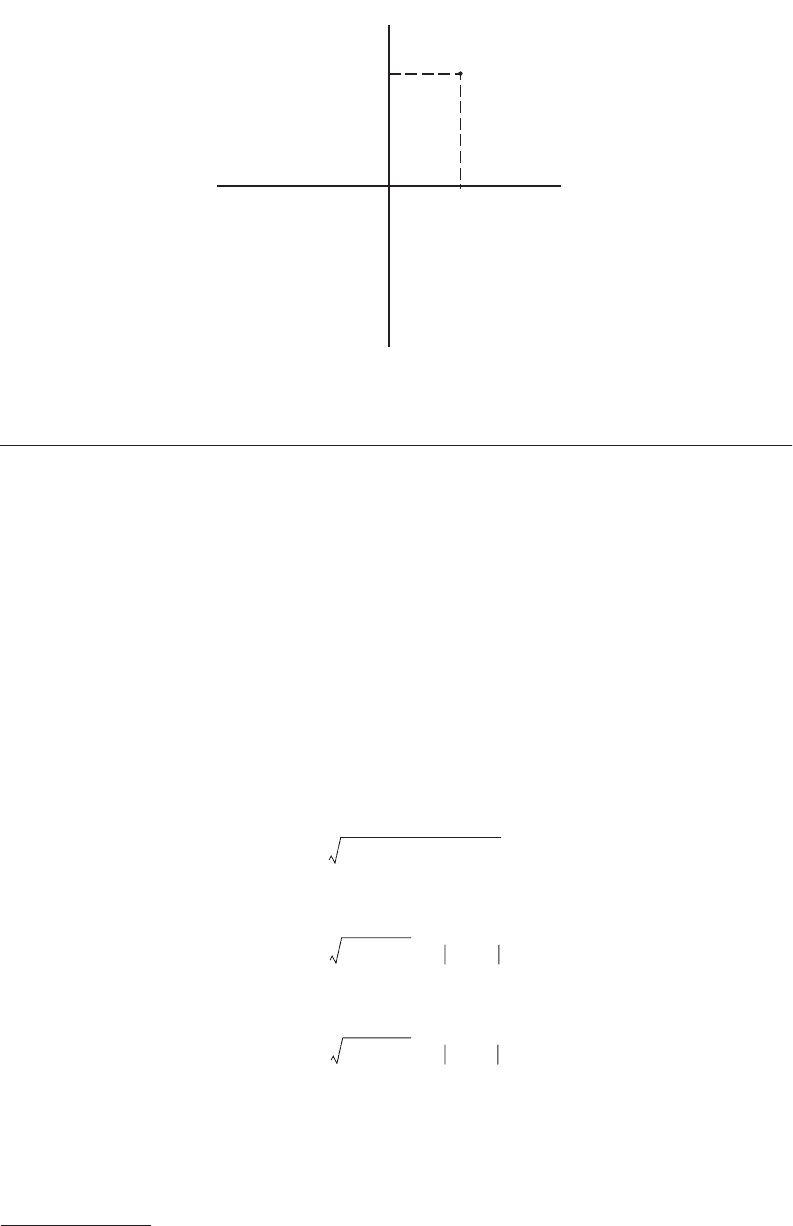
© 2003 by CRC Press LLC
Analytic Geometry
Rectangular Coordinates
The points in a plane may be placed in one-to-one correspondence with pairs of real numbers. A common
method is to use perpendicular lines that are horizontal and vertical and intersect at a point called the
origin. These two lines constitute the coordinate axes; the horizontal line is the x-axis and the vertical
line is the
y-axis. The positive direction of the x-axis is to the right, whereas the positive direction of the
y-axis is up. If P is a point in the plane, one may draw lines through it that are perpendicular to the x-
and
y-axes (such as the broken lines of Figure 15). The lines intersect the x-axis at a point with coordinate
x
1
and the y-axis at a point with coordinate y
1
. We call x
1
the x-coordinate, or abscissa, and y
1
is termed
the
y-coordinate, or ordinate, of the point P. Thus, point P is associated with the pair of real numbers
(
x
1
, y
1
) and is denoted P(x
1
, y
1
). The coordinate axes divide the plane into quadrants I, II, III, and IV.
Distance between Two Points; Slope
The distance d between the two points P
1
(x
1
, y
1
) and P
2
(x
2
, y
2
) is
In the special case when P
1
and P
2
are both on one of the coordinate axes, for instance, the x-axis,
or on the y-axis,
The midpoint of the line segment P
1
P
2
is
FIGURE 15 Rectangular coordinates.
y
x
IV
I
II
III
0
y
1
x
1
P(x
1
, y
1
)
dx
2
x
1
–()
2
y
2
y
1
–()
2
+=
dx
2
x
1
–()
2
x
2
x
1
–= =
dy
2
y
1
–()
2
y
2
y
1
–= =
x
1
x
2
+
2
----------------
y
1
y
2
+
2
---------------
,
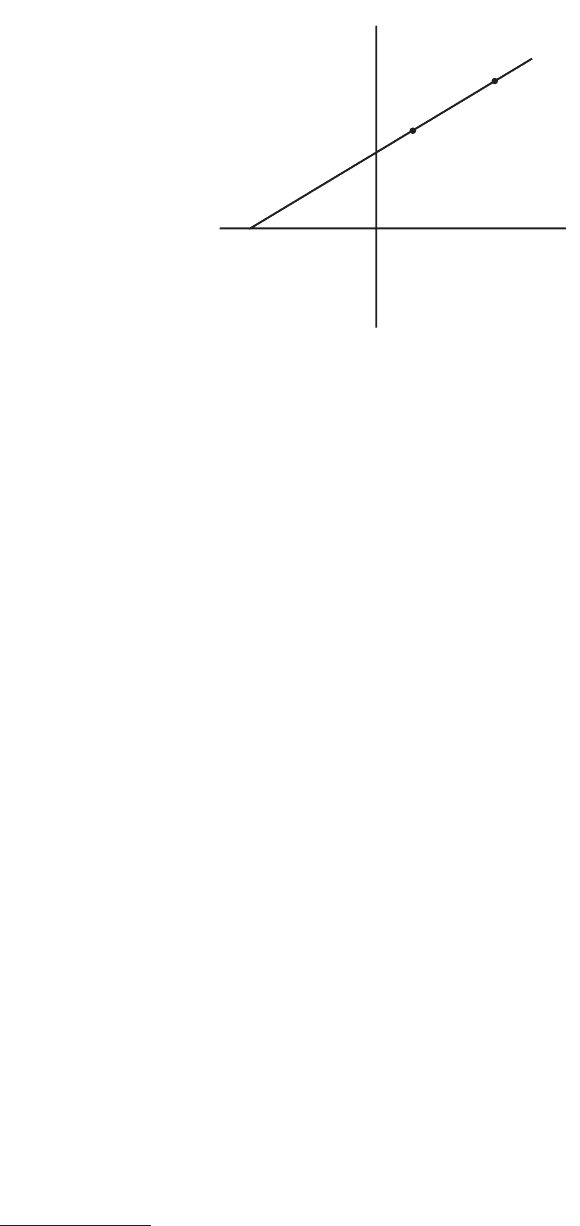
© 2003 by CRC Press LLC
The slope of the line segment P
1
P
2
, provided it is not vertical, is denoted by m and is given by
The slope is related to the angle of inclination α (Figure 16) by
Two lines (or line segments) with slopes m
1
and m
2
are perpendicular if
and are parallel if m
1
= m
2
.
Equations of Straight Lines
A vertical line has an equation of the form
where (c, 0) is its intersection with the x-axis. A line of slope m through point (x
1
, y
1
) is given by
Thus, a horizontal line (slope = 0) through point (x
1
, y
1
) is given by
A nonvertical line through the two points P
1
(x
1
, y
1
) and P
2
(x
2
, y
2
) is given by either
or
FIGURE 16 The angle of inclination α is the smallest angle measured counterclockwise from the positive x-axis to
the line that contains
P
1
P
2
.
y
x
P
1
P
2
α
m
y
2
y
1
–
x
2
x
1
–
---------------=
m
α
tan=
m
1
1 m
2
⁄–=
xc=
yy
1
– mx x
1
–()=
yy
1
=
yy
1
–
y
2
y
1
–
x
2
x
1
–
---------------
xx
1
–()=
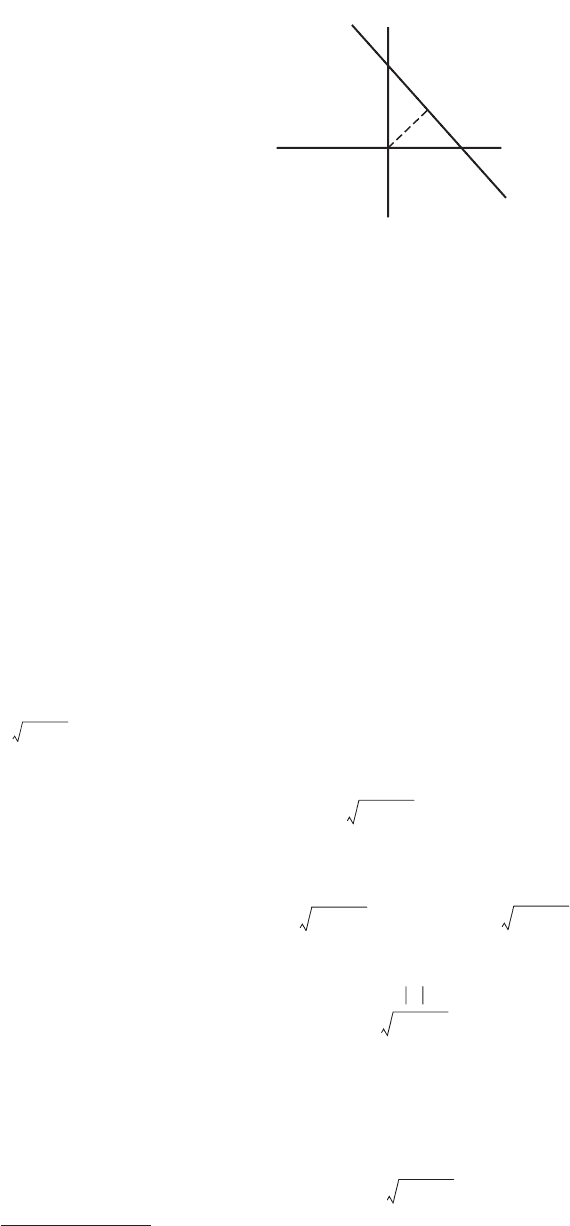
© 2003 by CRC Press LLC
A line with x-intercept a and y-intercept b is given by
The general equation of a line is
The normal form of the straight-line equation is
where p is the distance along the normal from the origin and θ is the angle that the normal makes with
the
x-axis (Figure 17).
The general equation of the line Ax + By + C = 0 may be written in normal form by dividing by
, where the plus sign is used when C is negative and the minus sign is used when C is positive:
so that
and
Distance from a Point to a Line
The perpendicular distance from a point P(x
1
, y
1
) to the line Ax + By + C = 0 is given by
FIGURE 17 Construction for normal form of straight-line equation.
y
x
0
p
θ
yy
2
–
y
2
y
1
–
x
2
x
1
–
---------------
xx
2
–()=
x
a
--
y
b
--+ 1 a 0 b 0≠,≠( )=
A
x By C++ 0=
x
θ
+ y
θ
sincos p=
A
2
B
2
+±
Ax By C++
A
2
B
2
+±
------------------------------ 0=
θ
cos
A
A
2
B
2
+±
-------------------------
θ
sin,
B
A
2
B
2
+±
-------------------------= =
p
C
A
2
B
2
+
----------------------=
d
Ax
1
By
1
C++
A
2
B
2
+±
----------------------------------=
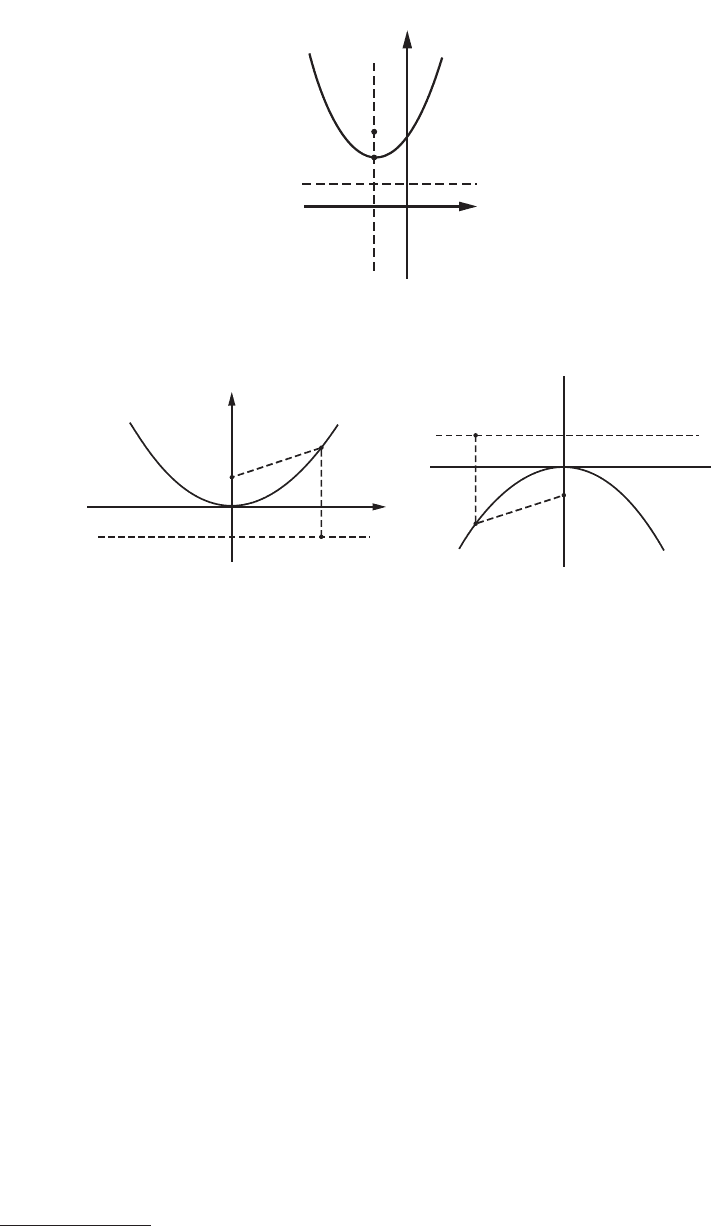
© 2003 by CRC Press LLC
Circle
The general equation of a circle of radius r and center at P(x
1
, y
1
) is
Parabola
A parabola is the set of all points (x, y) in the plane that are equidistant from a given line called the
directrix and a given point called the focus. The parabola is symmetric about a line that contains the
focus and is perpendicular to the directrix. The line of symmetry intersects the parabola at its
vertex
(Figure 18). The eccentricity e = 1.
The distance between the focus and the vertex, or vertex and directrix, is denoted by p (> 0) and leads
to one of the following equations of a parabola with vertex at the origin (Figures
19 and 20):
FIGURE 18 Parabola with vertex at (h, k). F identifies the focus.
FIGURE 19 Parabolas with y-axis as the axis of symmetry and vertex at the origin. (Left) ; (right)
x
o
F
y
x
=
h
(
h
,
k
)
F
0
0
F
y = p
y = −p
x
y
P
(
x
,
y
)
y
x
2
4p
------=
y
x
2
4p
------– .=
xx
1
–()
2
yy
1
–()
2
+ r
2
=
y
x
2
4p
------
(opens upward)=
y
x
2
4p
------
(opens downward)–=
x
y
2
4p
------
(opens to right)=
x
y
2
4p
------
(opens to left)–=
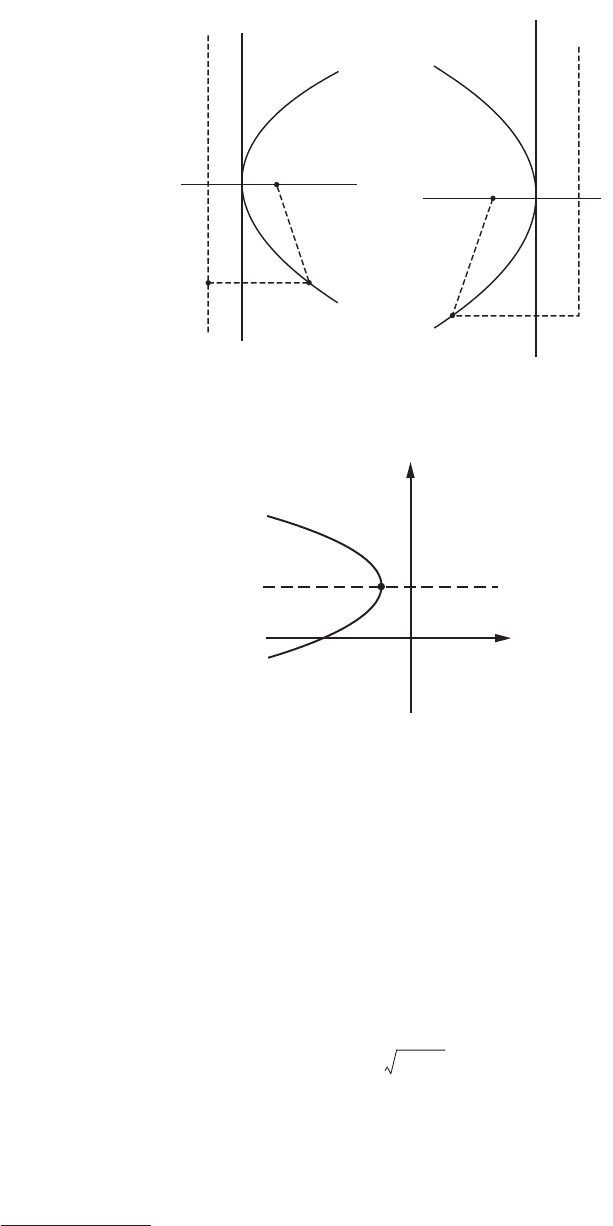
© 2003 by CRC Press LLC
For each of the four orientations shown in Figures 19 and 20, the corresponding parabola with vertex
(
h, k) is obtained by replacing x by x – h and y by y – k. Thus, the parabola in Figure 21 has the equation
Ellipse
An ellipse is the set of all points in the plane such that the sum of their distances from two fixed points,
called
foci, is a given constant 2a. The distance between the foci is denoted 2c; the length of the major
axis is 2
a, whereas the length of the minor axis is 2b (Figure 22) and
The eccentricity of an ellipse, e, is < 1. An ellipse with center at point (h, k) and major axis parallel to
the x-axis
(Figure 23) is given by the equation
FIGURE 20 Parabolas with x-axis as the axis of symmetry and vertex at the origin. (Left) ; (right)
FIGURE 21 Parabola with vertex at (h, k) and axis parallel to the x-axis.
y
x = p
x
0
F
x
F
0
x = −p
x
y
2
4p
------= x
y
2
4p
------– .=
0
x
(
h
,
k
)
y
y
=
k
xh–
yk–()
2
4p
------------------–=
ab
2
c
2
+=
xh–()
2
a
2
------------------
yk–()
2
b
2
------------------+ 1=
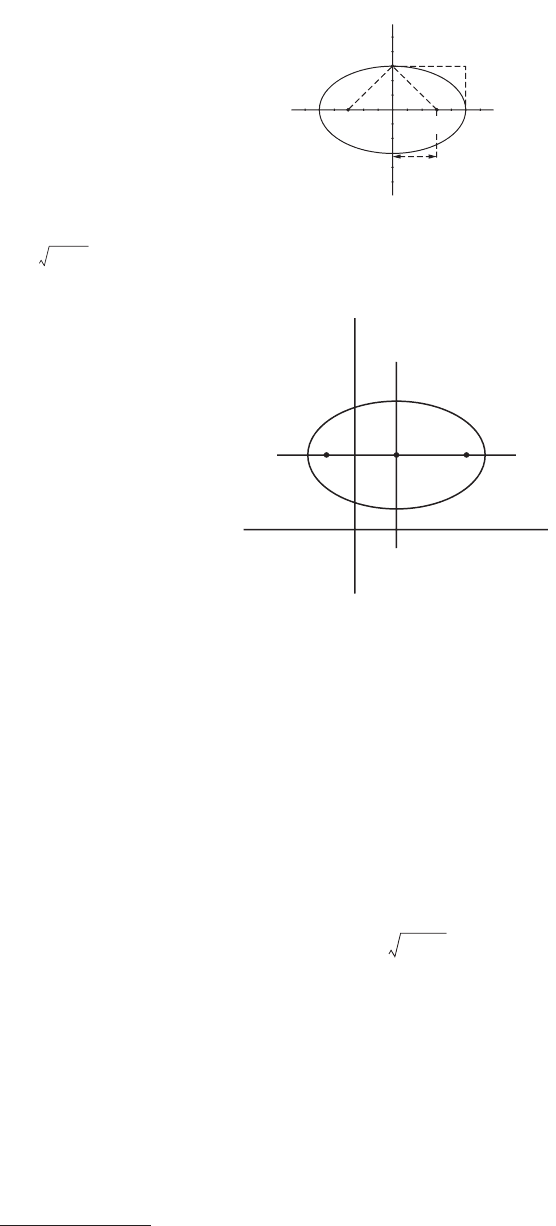
© 2003 by CRC Press LLC
An ellipse with center at (h, k) and major axis parallel to the y-axis is given by the equation (Figure 24)
Hyperbola (e > 1)
A hyperbola is the set of all points in the plane such that the difference of its distances from two fixed
points (foci) is a given positive constant denoted 2
a. The distance between the two foci is 2c and that
between the two vertices is 2
a. The quantity b is defined by the equation
and is illustrated in Figure 25, which shows the construction of a hyperbola given by the equation
When the focal axis is parallel to the y-axis, the equation of the hyperbola with center (h, k) (Figures 26
and 27) is
FIGURE 22 Ellipse. Since point P is equidistant from foci F
1
and F
2
, the segments F
1
P and F
2
P = a; hence,
FIGURE 23 Ellipse with major axis parallel to the x-axis. F
1
and F
2
are the foci, each a distance c from center (h, k).
x
y
b
a
P
c
0
F
2
F
1
ab
2
c
2
+ .=
F
2
F
1
y = k
x
0
x = h
y
yk–()
2
a
2
------------------
xh–()
2
b
2
------------------+ 1=
bc
2
a
2
–=
x
2
a
2
----
y
2
b
2
----– 1=
yk–()
2
a
2
------------------
xh–()
2
b
2
------------------– 1=
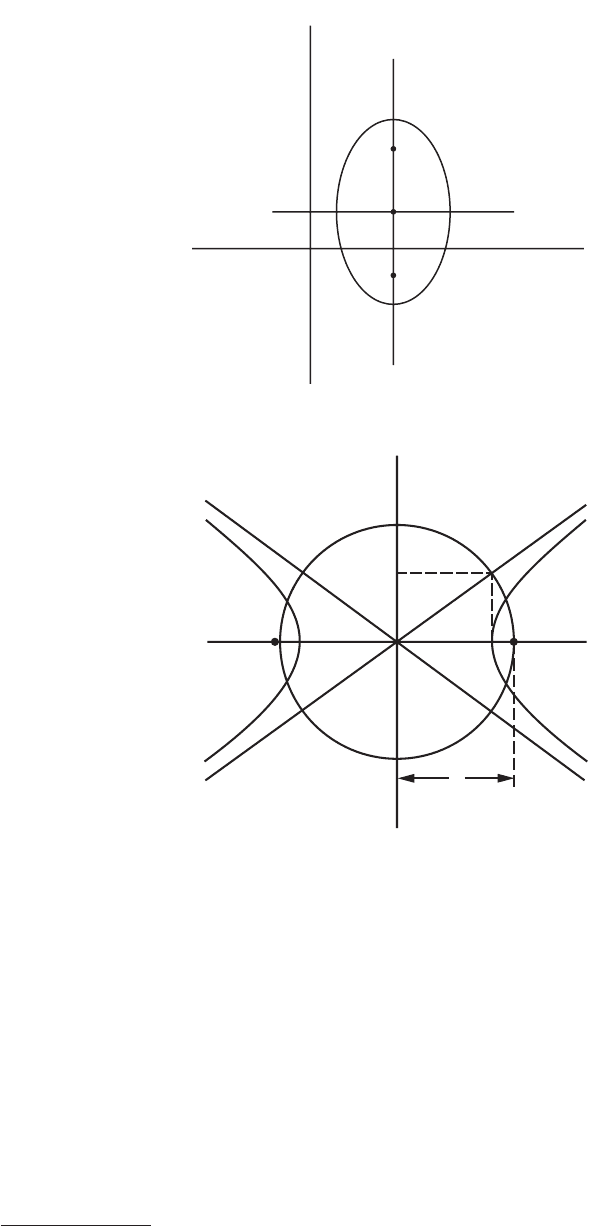
© 2003 by CRC Press LLC
If the focal axis is parallel to the x-axis and center (h, k), then
Change of Axes
A change in the position of the coordinate axes will generally change the coordinates of the points in the
plane. The equation of a particular curve will also generally change.
Translation
When the new axes remain parallel to the original, the transformation is called a translation (Figure 28).
The new axes, denoted x′and y′, have origin 0′ at (h, k) with reference to the x- and y-axes.
FIGURE 24 Ellipse with major axis parallel to the y-axis. Each focus is a distance c from center (h, k).
FIGURE 25 Hyperbola. V
1
, V
2
= vertices; F
1
, F
2
= foci. A circle at center 0 with radius c contains the vertices and
illustrates the relation among
a, b, and c. Asymptotes have slopes b/a and –b/a for the orientation shown.
F
F
0
x
y = k
x = h
y
X
Y
b
a
c
0
c
V
1
F
1
V
2
F
2
xh–()
2
a
2
------------------
yk–()
2
b
2
------------------– 1=
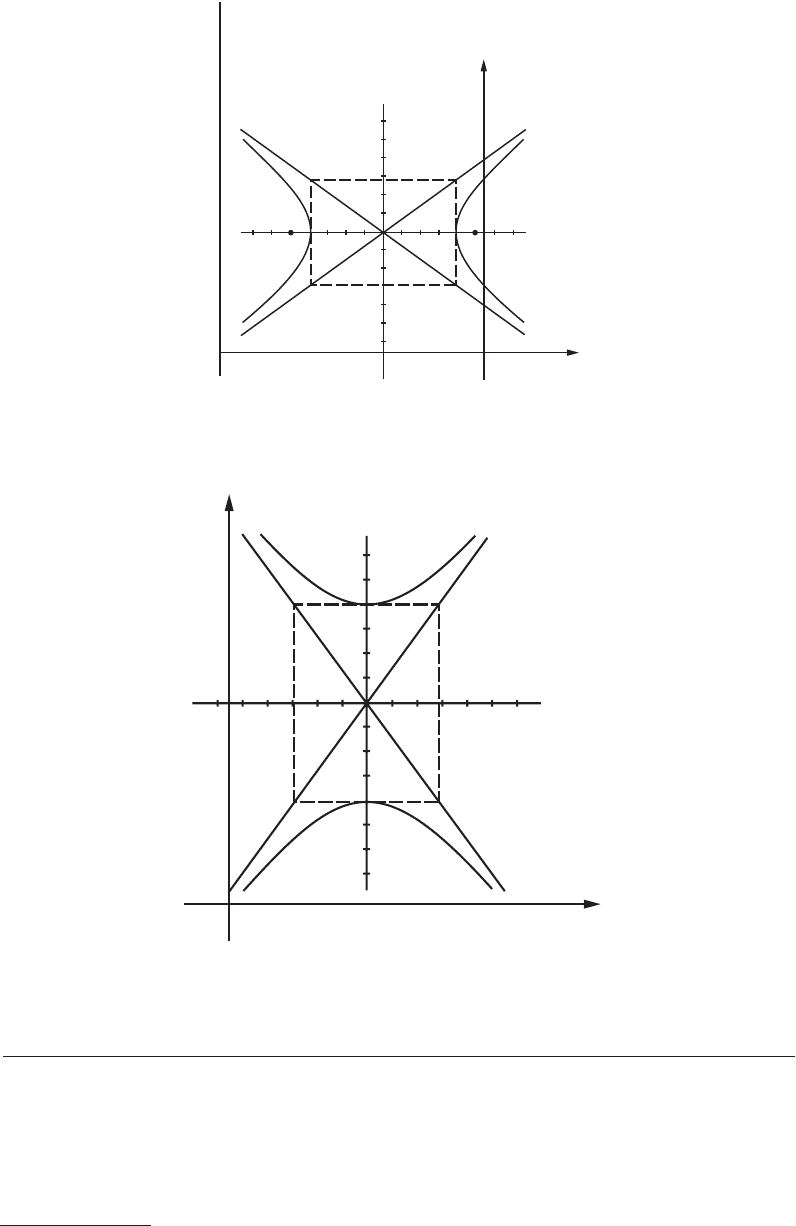
© 2003 by CRC Press LLC
Series
Bernoulli and Euler Numbers
A set of numbers, B
1
, B
3
, K, B
2n – 1
(Bernoulli numbers) and B
2
, B
4
, K, B
2n
(Euler numbers), appears in
the series expansions of many functions. A partial listing follows; these are computed from the following
equations:
FIGURE 26 Hyperbola with center at (h, k). slopes of asymptotes ± b/a.
FIGURE 27 Hyperbola with center at (h, k). slopes of asymptotes ± a/b.
x = h
b
a
y = k
0
x
y
xh–()
2
a
2
------------------
yk–()
2
b
2
------------------– 1;=
y
x = h
a
b
y = k
x
0
yk–()
2
a
2
------------------
xh–()
2
b
2
------------------– 1;=
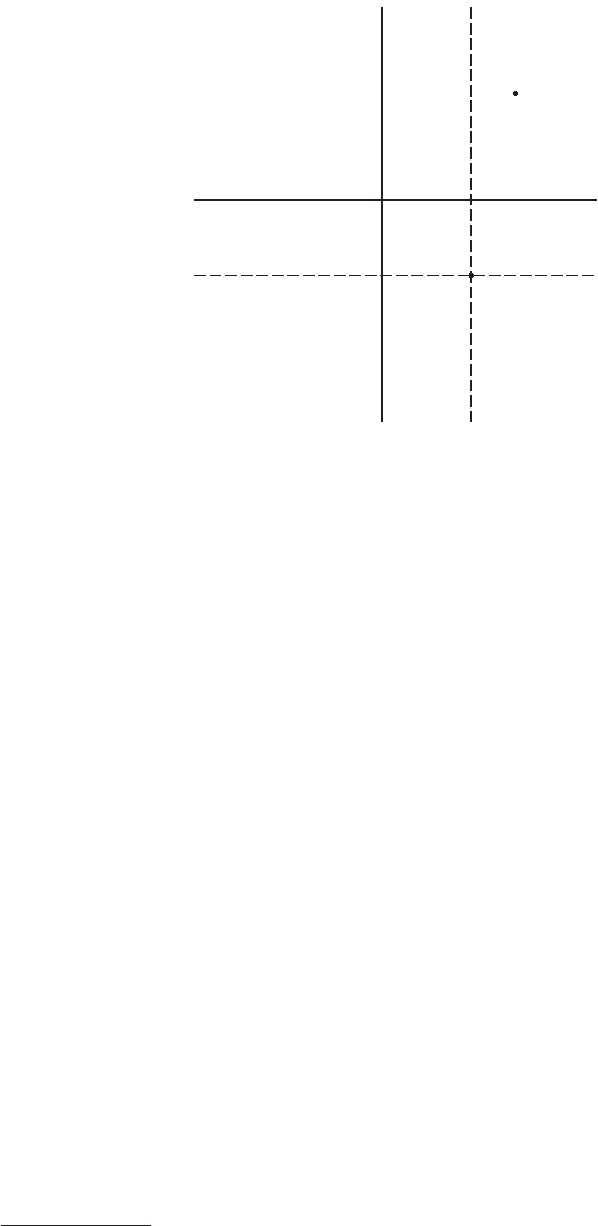
© 2003 by CRC Press LLC
and
Series of Functions
In the following, the interval of convergence is indicated; otherwise, it is all x. Logarithms are of base e.
Bernoulli and Euler numbers (
B
2n – 1
and B
2n
) appear in certain expressions.
FIGURE 28 Translation of axes.
y
0
P
y′
x′
x
0′ (h, k)
B
2n
2n 2n 1–()
2!
--------------------------
B
2n 2–
–
2n 2n 1–()2n 2–()2n 3–()
4!
-------------------------------------------------------------------
B
2n 4–
L– 1–()
n
+ + 0=
2
2n
2
2n
1–()
2n
----------------------------
B
2n 1–
2n 1–()B
2n 2–
2n 1–()2n 2–()2n 3–()
3!
------------------------------------------------------------
B
2n 4–
– L 1–()
n 1–
++=
B
1
16⁄ B
2
1= =
B
3
130⁄ B
4
5= =
B
5
142⁄ B
6
61= =
B
7
130⁄ B
8
1385= =
B
9
566⁄ B
10
50,521= =
B
11
691 2730⁄ B
12
2,702,765= =
B
13
76⁄ B
14
199,360,981= =
M M
ax+()
n
a
n
na
n 1–
x
nn 1–()
2!
--------------------
a
n 2–
x
2
nn 1–()n 2–()
3!
-------------------------------------
a
n 3–
x
3
L
n!
nj–()!j!
---------------------
a
nj–
x
j
L
++ + +
+ +
= x
2
a
2
<[]
